What are wild horses?
Wild horses are free-roaming horses descended from domestic livestock. Wild horses occur across many areas throughout Australia and can vary greatly in genetics, size, shape, and origin. Collectively, wild horses are also referred to as feral horses and brumbies.

Free-roaming wild horses, also known as feral horses and brumbies.
Why are horses considered a pest?
Wild horses are considered to be a pest animal because of the damage they cause to the environment. Wild horses can:
- increase soil erosion – by killing vegetation, disturbing the soil and creating paths along frequently used routes
- destroy native plants – by grazing and trampling
- foul waterholes
- cause the collapse of wildlife burrows
- compete with native animals for food and shelter
- compete with livestock for pastures – particularly during periods of drought
- spread weeds – through their dung and in their hair
- spread disease
- pose a risk to public safety – such as on high speed roads and highways.
Managing horses in our national parks
The National Parks and Wildlife Service (NPWS) manages wild horses in New South Wales national parks to protect threatened species, native plants, animals, landscapes, and to limit the impact on neighbouring properties. We recognise that there is a wide variety of views within the community regarding the management of horses within conservation areas.
NPWS, like other land managers, has a general biosecurity duty under the NSW Biosecurity Act 2015. With this in mind, management is prioritised through regional pest management strategies, the Saving our Species program, and specific horse management plans that are used in conjunction with each park’s plan of management.
National parks with horse management plans
Guy Fawkes River National Park, Kosciuszko National Park, Oxley Wild Rivers National Park and Barrington Tops National Park have horse management plans: